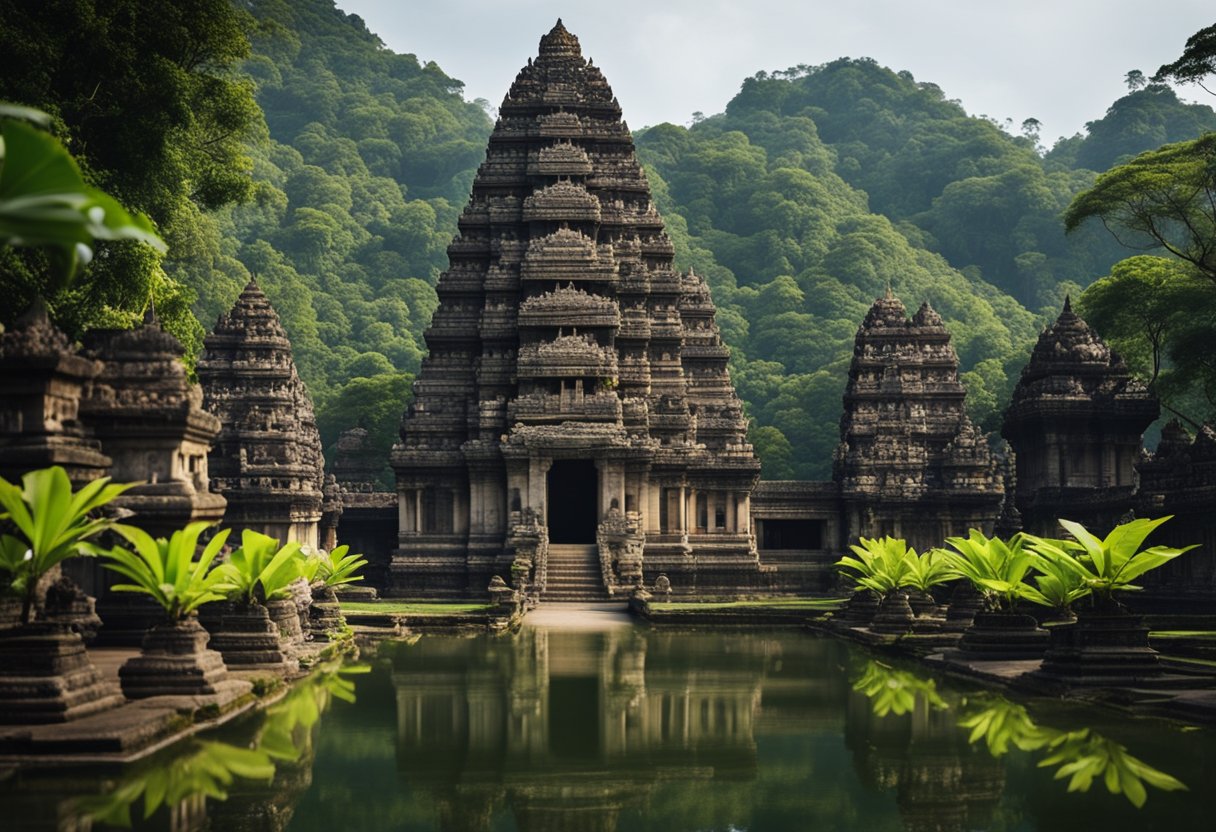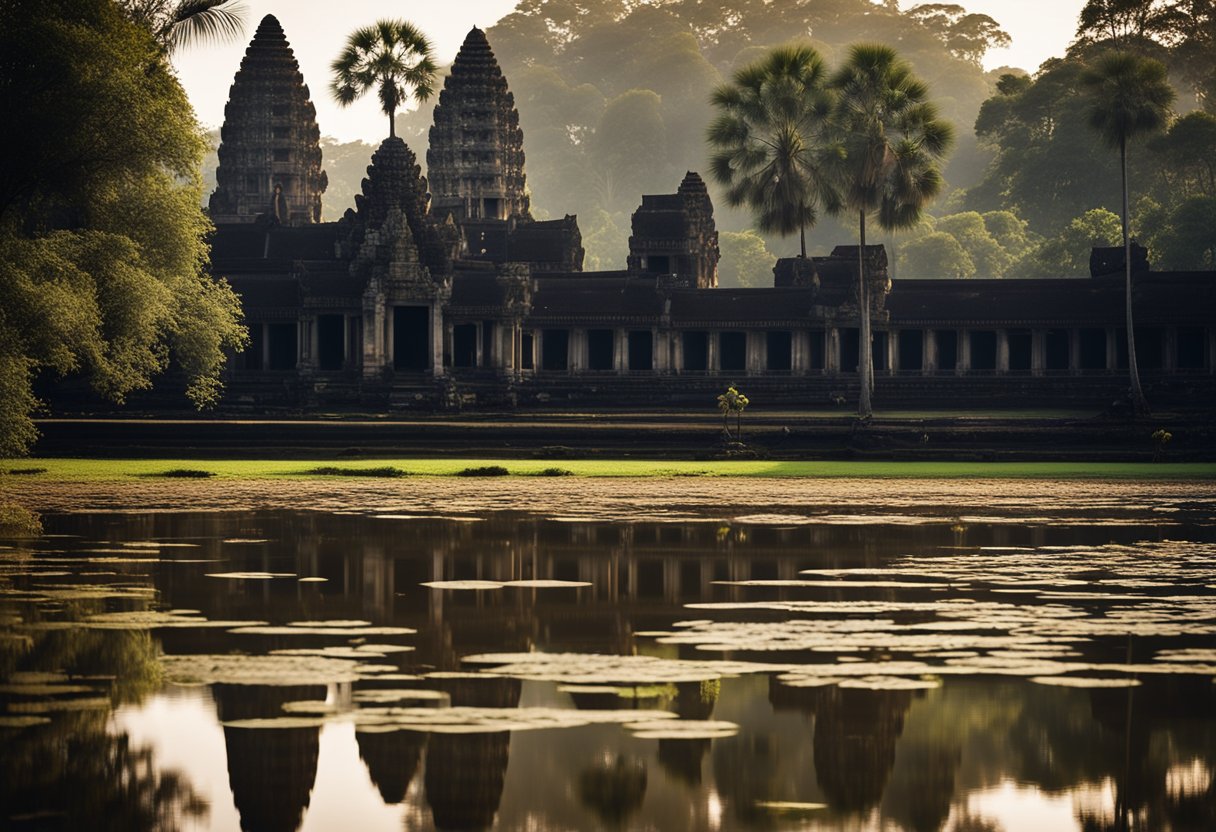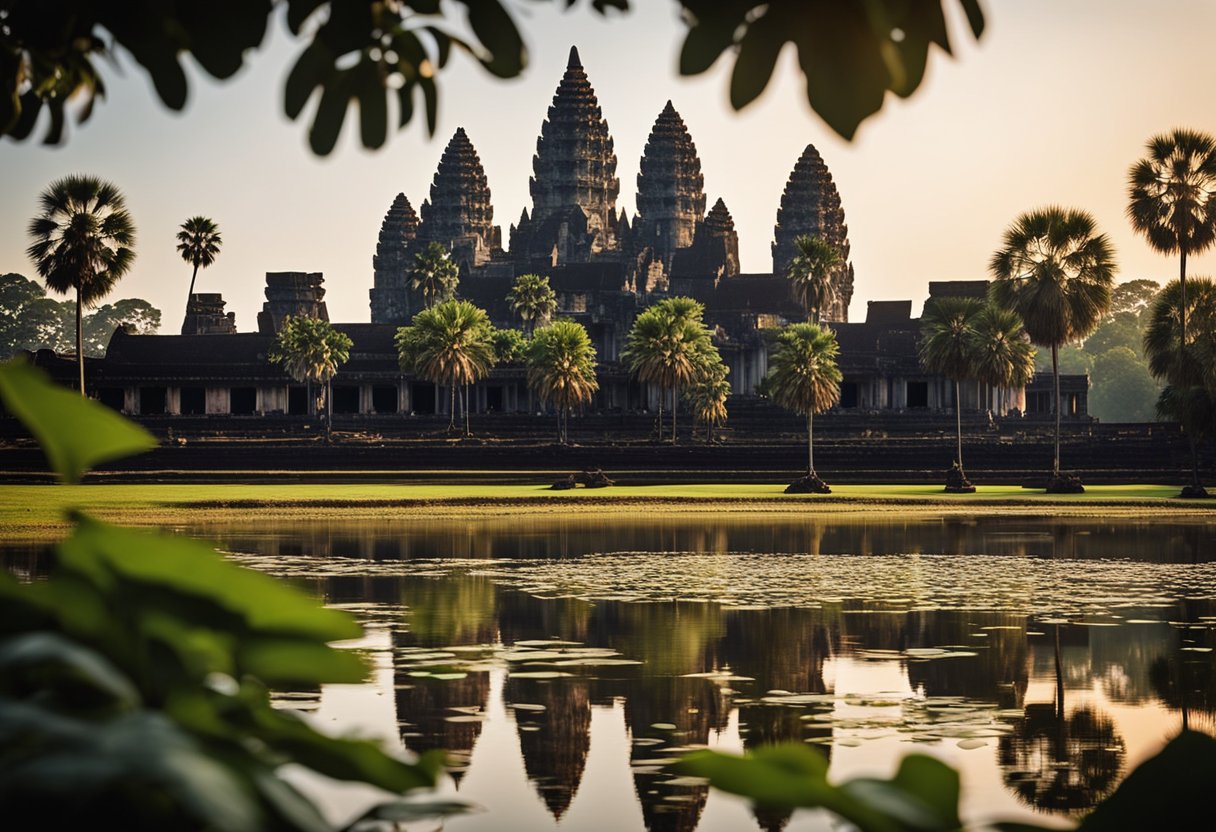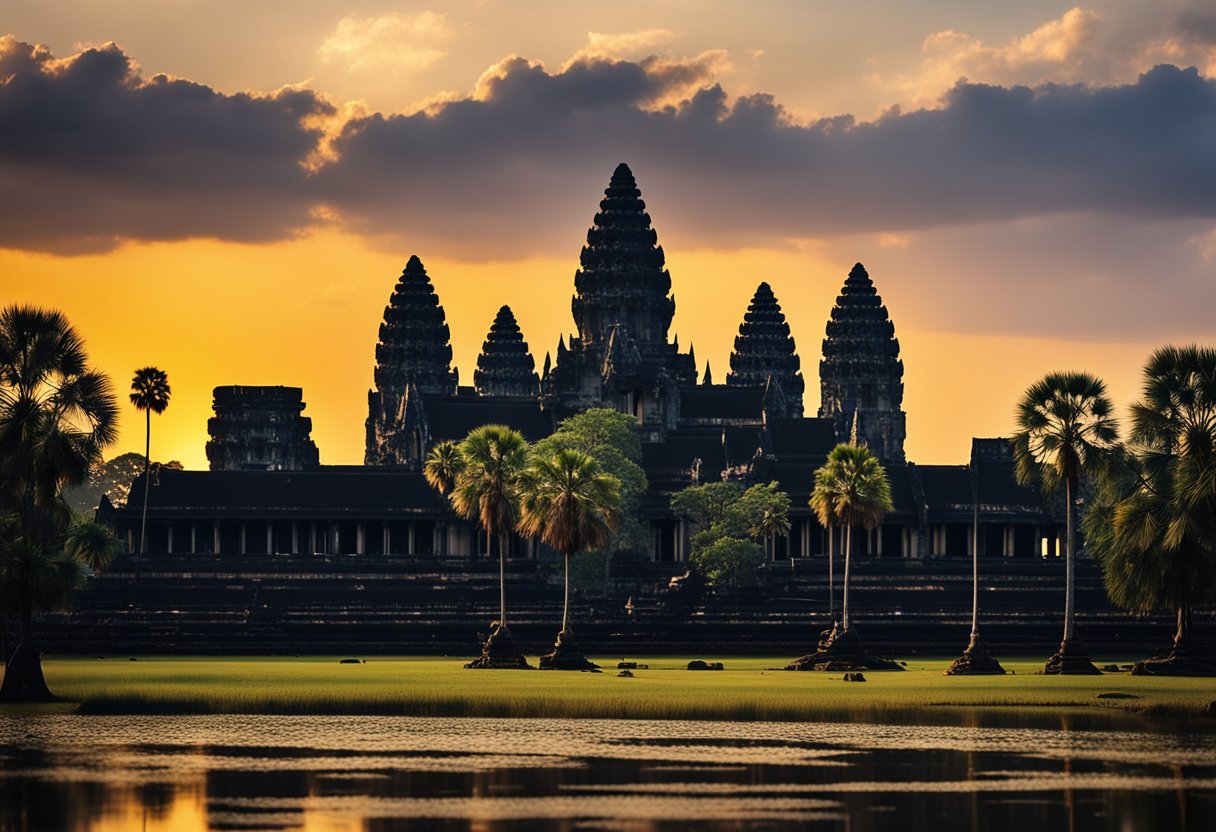The Khmer Empire: Unveiling the Grandeur and Enigma of Angkor Wat’s Architecture

Updated On: March 26, 2024 by Maha Yassin
Nestled in the heart of Southeast Asia, Cambodia’s Angkor Wat stands as an enduring symbol of the Khmer Empire’s architectural genius and enigmatic past. Constructed in the 12th century, this UNESCO World Heritage Site captures the essence of the empire’s sophistication, evident in its grandiose structures and intricate carvings. Once the epicentre of the empire, Angkor Wat serves not just as a spiritual beacon but as a mirror to the celestial alignments, embodying the Khmer’s intricate understanding of the cosmos.
As the largest religious monument in the world, the temple complex of Angkor Wat is a testament to the empire’s mastery of engineering and artistry. Its five iconic towers echo the peaks of Mount Meru, the home of the gods in Hindu mythology, fusing religious symbolism with imposing architecture. The surrounding moat and vast reservoirs speak to an advanced understanding of water management, which is crucial for sustaining the sprawling city and farmlands. The temple’s walls are canvases for exquisite bas-reliefs that chronicle Hindu epics and the Khmer dynasty’s historical narratives with profound artistic expression.
Historical Context of The Khmer Empire
As we uncover the history of the breathtaking Angkor Wat, we find ourselves entwined with the narrative of the Khmer Empire, spanning several centuries and witnessing powerful reigns that shaped Southeast Asia’s cultural and political landscapes.
Origins of the Khmer Empire
The Khmer Empire, monumental in its achievements, sprang to prominence in the early 9th century. It flourished in present-day Cambodia, with influences reaching Thailand, Vietnam, Laos, and Myanmar. The empire’s foundation was attributed to Jayavarman II, who declared independence from Java and initiated a dynasty that would reign for over 600 years. This empire was a crucible of Hindu and Buddhist beliefs, fostering a unique cultural fusion still admired today.
Reign of King Suryavarman II
During the 12th century, one of the most remarkable and prolific characters ascended to the throne: King Suryavarman II. He was instrumental in establishing Hinduism as the state religion and commissioning Angkor Wat, adding to the empire’s architectural triumphs. His reign consolidated the empire’s power, extending its reach and laying the grounds for an enduring legacy.
Cultural and Political Influence
The Khmer Empire was a powerhouse of artistic and architectural innovation, reflecting its Hindu and Buddhist roots. The cultural significance was further amplified under King Jayavarman VII, who shifted the state religion to Mahayana Buddhism. The political might of the Khmer reached out to neighbouring regions such as China and beyond, securing its position as a dominant force in Southeast Asia.
The Decline and Fall
The once-mighty Khmer Empire began to wane during the 14th and 15th centuries, succumbing to internal strife and pressure from neighbouring kingdoms. Historical texts hint at environmental factors also contributing to its decline. The empire’s fall saw its territories eventually fall under the influence of Thailand and Vietnam. Centuries later, parts of the former empire were colonised by France, becoming part of French Indochina. The echoes of the empire’s demise resonated through history, up until the 20th century, with the rise and fall of the Khmer Rouge.
Angkor Wat: Architectural Overview
We find that Angkor Wat, the crowning jewel of the Khmer Empire, is a testament to architectural prowess and a monumental tribute to the celestial and religious devotion of a bygone era.
Design and Layout
The temple complex represents Mount Meru, the home of the gods in Hindu mythology, showcasing a classical style of Khmer architecture. It is laid out in a distinctive temple mountain form, signifying its role as a bridge between earth and heaven. The concentric galleries are connected by a network of passageways, with each ascending level representing increased sanctity. Angkor Wat is encased by a vast moat, symbolising the cosmic ocean.
Construction Techniques
Angkor Wat’s architecture was achieved through sandstone and laterite, with precise masonry that often required no mortar. Intricate bas-reliefs adorn the temple walls, depicting scenes from Hindu epics and the gods, prominently featuring Vishnu. Advanced engineering techniques of the Khmer are evident in the seamless stone joints and the corbelling method used to fashion arches and vaults within the complex.
Astronomical and Religious Significance
Angkor Wat’s alignment and dimensions are believed to have astronomical significance, with certain features aligning during solar events. This masterful architecture also serves a deeply religious purpose, with its spatial harmony embodying Hindu beliefs in order and the cosmos. As a former Hindu god Vishnu temple, which later became a Buddhist site, it has remained a continuous place of worship, contributing to its acclaim as a World Heritage site.
Artistic Expressions
The Khmer Empire’s legacy in art and architecture is one of the most significant marks on Cambodian culture. It captures a rich tapestry of Hindu mythology and history through its visual narratives and ornate structures. Our exploration unveils the intricate iconography and symbolism, remarkable bas-reliefs and sculptures, and the ethereal beauty of the Apsara and Devata figures that adorn Angkor Wat.
Iconography and Symbolism
The art carved into the stone walls of Angkor Wat is steeped in Hindu mythology, particularly the epics of the Ramayana and Mahabharata. Each image is more than an aesthetic choice; these carvings represent the divine and the cosmic order. Scenes depicting celestial beings and deities are replete with symbolism, illustrating both historical events and mythological tales that convey deep-seated beliefs and values of the Khmer people.
Bas-Reliefs and Sculptures
Angkor Wat abounds with bas-relief sculptures that grace its galleries, telling stories and showcasing events from sacred texts. These bas-reliefs stand as a testament to the mastery of Khmer art, with every minute detail meticulously chiselled to perfection. They serve a decorative purpose and function as a narrative device to impart religious teachings and celebrate historical victories.
The Apsaras and Devatas
Angkor Wat’s walls are famously adorned with over 3,000 enchanting Apsara and Devata figures, each expertly crafted and unique in their attire and posture. These celestial dancers and deities are emblematic of Cambodian culture, encapsulating grace, beauty, and the divine. They reflect the importance of dance and art in worship and the spiritual connection the Khmer Empire attributed to aesthetic expressions.
Through the language of art, these carvings and statues breathe life into stone, preserving stories and traditions from a bygone era for future generations to admire and learn from.
Religious Dimensions
Before we delve into the subtleties of Angkor Wat’s religious layers, it’s essential to acknowledge its deep-rooted Hindu beginnings and the eventual embrace of Buddhism that has left an indelible mark on its spiritual identity. Angkor Wat has been an epicentre of faith and pilgrimage, reflecting the Khmer Empire’s religious dynamism.
Hindu Foundations
Angkor Wat was originally conceived as a Hindu temple dedicated to Vishnu. Commissioned by King Suryavarman II in the early 12th century, this majestic site was a testament to the cosmological beliefs of Hinduism, symbolically representing the Hindu universe. The five central towers mimic the peaks of Mount Meru, home of the gods in Hindu mythology, with moats and concentric walls symbolising the ocean and mountain ranges that cosset the earthly realm.
Transition to Buddhism
Over time, Angkor Wat underwent a significant and harmonious transition, becoming a Buddhist site by the end of the 12th century. The empire’s shifting spiritual allegiance is mirrored in the temple’s architecture and art, with many of the Hindu images and deities, such as Brahma and Indra, assimilated or modified to reflect Buddhist iconography. This blending of faiths created a remarkable Hindu-Buddhist temple, showcasing the fluidity of Khmer worship.
Modern Spiritual Practices
Today, Angkor Wat is a crucial pilgrimage site for Hindu and Buddhist followers. Pilgrims from far and wide visit this sacred space to pay homage and practice their faith. The ongoing spiritual use of Angkor Wat reinforces its status as a living religious monument. Of particular note is the prominence of Theravada Buddhism in modern Cambodia, which further highlights the site’s continuous evolution and veneration.
Engineering Marvels
In our exploration of Angkor Wat, we unearth remarkable feats of Khmer engineering that continue to inspire awe. From sophisticated water management to innovative construction techniques, these marvels showcase an empire’s mastery over its environment and resources.
Hydraulic Systems
The Khmer Empire’s architects excelled in creating an intricate network of reservoirs and canals, forming a robust irrigation system essential for sustaining a sprawling metropolis. The Baray, or water reservoirs such as the West Baray, are monumental in scale and crucial for water management, essential for both agriculture and the stability of the empire’s structures.
Structural Innovations
Angkor Wat’s layout demonstrates a sophisticated understanding of structural engineering and spatial geometry. Not only did the iconic central temple mount represent the cosmic Mount Meru, but its concentric galleries also showcased an innovative use of laterite and sandstone. The exacting placement of these heavy stones without the use of mortar is a testament to the skill of the Khmer constructors.
Materials and Resources
The Khmer architects utilised locally available materials to their advantage. Sandstone, quarried from the Kulen hills, was transported via canal systems and laid precisely in the temple’s construction. Laterite, used in hidden sections of the monuments, was favoured for its durability and ease of quarrying. Through resourcefulness and ingenuity, these materials were transformed into an architectural wonder that has endured centuries.
Ecological and Societal Impact

In discerning the ecological and societal impact of the Khmer Empire, particularly with their capital at Angkor Wat, it’s essential to consider the elaborate urban planning and agriculture that supported what was once the largest preindustrial city in the world and the environmental challenges that ensued from such grandeur. These two facets collectively influenced both the rise and eventual decline of the Khmer civilisation.
Urban Planning and Agriculture
Angkor Wat’s urban planning was a testament to the Khmer Empire’s meticulous organisation and profound understanding of environmental engineering. They constructed elaborate reservoirs and water management systems that exemplified advanced hydrological knowledge for irrigation, which was crucial for their staple crop, rice. The agricultural prowess of the empire not only sustained its population but also fortified its status and influence across the region.
Environmental Challenges
The construction and maintenance of this magnificent city were not without its environmental hurdles. Deforestation was prevalent, primarily to clear land for agriculture and maintain the growing needs of an expanding city. This significantly altered the natural jungle landscape, impacting the local environment and potentially contributing to the societal decline. Sustaining the city’s vast infrastructure in the face of these ecological changes posed considerable challenges.
By appreciating the intricate relationship between Angkor Wat’s construction and ecological footprint, we deepen our understanding of how their ambitious urban planning advanced and, at times, strained societal developments within the Khmer Empire.
Conservation and Restoration

Although revered as an architectural masterpiece, Angkor Wat has been subjected to natural deterioration and human impact over the centuries. Recognising the need to preserve this symbol of Khmer ingenuity, concerted conservation and restoration efforts are underway to safeguard its future.
Preservation Efforts
Since the monument’s designation as a UNESCO World Heritage site, the international community has taken significant steps to ensure the conservation of Angkor Wat. Various partnerships and funding initiatives have been forged, including efforts by the World Monuments Fund (WMF), which has implemented conservation training and educational programmes. These initiatives focus on skill development in conservation techniques crucial for ongoing restoration works. The work extends to consolidating free-standing structures and protecting vulnerable carvings and sculptures that narrate the Khmer Empire’s history.
- Key Areas of WMF Intervention:
- Churning of the Ocean of Milk Gallery within Angkor Wat
- Phnom Bakheng temple
- Preah Khan Temple complex
World Heritage in Danger
Angkor Wat’s status on the World Heritage in Danger list, a designation by UNESCO for endangered cultural sites, has drawn attention to the challenges faced by this ancient complex. Threats include looting, illicit trafficking of artefacts, and environmental stressors that require an active response to mitigate. Strategic planning and management of the site are essential to combat these issues, involving both local authorities and international experts. The goal is to balance preserving Angkor Wat’s integrity and ensuring future generations can appreciate it.
Angkor Wat in Modern Culture
Angkor Wat is not only a stunning testament to the architectural feats of the Khmer Empire. Still, it continues to mould modern Cambodian identity and is prevalent in various forms of media and arts.
Influence on Cambodian Identity
The silhouette of Angkor Wat is intrinsically linked to the identity of Cambodia. The temple complex has become a symbol of national pride, so much so that an image of its towers features prominently on the Cambodian flag. This is unique among countries; Cambodia is one of the few that incorporates a specific building into its national standard. Moreover, the structure is seen as a definitive representation of Khmer architecture and heritage—signifying the enduring legacy of the Khmer people and their contribution to global civilisation.
For Cambodians, Angkor Wat is more than a monument; it plays a vital role in reflecting and shaping their culture. It features educational material, inspires classical arts, and is essential to spiritual and religious life. Its presence on everyday items, from currency to schoolbooks, shows its pervasive influence on Cambodian culture.
Representation in Media and Arts
As the backdrop for countless documentaries and films, Angkor Wat has found its way into living rooms and cinemas worldwide, solidifying its place as an iconic tourist attraction. Whether depicted in a historical drama or as an exotic location in blockbuster movies, Angkor Wat captures the imagination with its mystery and magnificence.
In the arts, Angkor Wat is a frequent subject for photography, paintings, and literature, and it is admired for its intricate design and the natural beauty surrounding it. In essence, these works celebrate the ancient temple complex and the skill and devotion of those who created it. The mystique of the ruins continues to inspire artists, writers, and musicians, weaving through the fabric of Cambodia’s burgeoning arts scene and finding resonance in contemporary expressions of creativity.
Through tourism, Angkor Wat contributes significantly to Cambodia’s economy. Every year, millions of tourists travel to witness its grandeur firsthand. This influx of visitors has made the site a cornerstone of the tourism industry, with the local community offering guided tours, cultural shows, and traditional crafts. The economic impact is substantial, providing employment and sustaining livelihoods for many Cambodians.
Angkor Wat is a powerful cultural emblem, bridging the past and present, and is central to our understanding of Cambodia and its remarkable heritage.
Exploration and Study
Our illuminated journey through the past brings us to the meticulous examination of the Khmer Empire, focusing on the architectural wonder of Angkor Wat. The enigma that shrouds the ancient ruins has drawn explorers and researchers alike, unravelling pieces of history piece by piece.
Early European Encounters
The Western world first caught a glimpse of Angkor Wat’s grandeur through the written accounts of Henri Mouhot, a French explorer who visited the site in the mid-19th century. His descriptions compelled others to follow, including Louis Delaporte, who played a pivotal role in documenting and bringing the splendour of Angkor to Paris, igniting the West’s fascination.
Ongoing Research and Discoveries
In recent years, research has leapt bounds forward, with technologies like LiDAR revealing the complex urban and hydraulic infrastructure that underpinned the Khmer civilisation. We continue to discover and understand the full extent of Angkor Wat’s ingenious design and significance, further solidifying its place as one of history’s architectural triumphs.
The Role of Tourism

Tourists from around the globe are drawn to the breathtaking remnants of the Khmer Empire, most notably Angkor Wat. Siem Reap has evolved into a bustling tourist hub, catering to the needs of those who come to marvel at this UNESCO World Heritage site. Our focus here is on visitor management and the impact of tourism on preservation.
Visitor Management
Angkor Wat’s status as a premier tourist attraction necessitates effective visitor management strategies to handle the influx of tourists, thus mitigating the effects of mass tourism. We’ve implemented ticketing systems that regulate the number of visitors and allocate specific times for tours to prevent crowding and overuse of vulnerable areas. Further, by promoting off-peak visits and alternative routes within the site, we aim to distribute the tourist load evenly.
Impact on Preservation
Tourism has both bolstered and burdened the preservation efforts at Angkor Wat. The revenue generated from tourism is vital for funding ongoing conservation work; however, the sheer volume of visitors can lead to wear and tear on the ancient structures. To tackle this, we have established strict zones within the complex where access is limited, and areas that require special attention are cordoned off periodically for restoration. This approach helps maintain the integrity of this architectural wonder while keeping it open to admirers from across the world.
Angkor Wat’s Global Legacy
Angkor Wat is more than a testament to the Khmer Empire’s ingenuity; it’s a beacon of cultural exchange and human genius. Enshrined within the Angkor Archaeological Park, this architectural marvel has cemented its place as the world’s largest religious structure.
The Khmer temples’ intricate designs and grand scale symbolise a thriving civilisation that valued both spiritual and aesthetic excellence. Angkor Wat’s five monumental towers, designed to mimic the sacred Mount Meru, inspire awe and significantly influence religious architecture globally.
Here, we list the enduring influences of Angkor Wat:
Cultural Expanse:
- Spiritual narratives: The temple’s bas-reliefs narrate Hindu epics, which continue to educate and fascinate.
- Architectural influence: Its design has been emulated across Southeast Asia and beyond.
Recognition:
- UNESCO Heritage Site: Recognising UNESCO as a World Heritage site helps preserve and share this wonder.
- Global inspiration: Angkor Wat has influenced global creators in everything from artwork to literature.
Through the potent combination of human creativity and natural overgrowth, this religious complex captures imaginations and inspires contemporary architects. Our appreciation for Angkor Wat transcends mere admiration; it is a commitment to preserving the enigma of ancient human achievement for future generations to study and cherish.
The legacy of Angkor Wat undeniably transcends time, with its sacred corridors and lofty spires narrating stories of a bygone era, ensuring the marvels of the Khmer Empire remain indelible in our shared cultural narrative.

FAQs
Angkor Wat captivates the curious mind and the scholarly eye, leaving many stunned by its architectural complexity and spiritual depth. Our exploration addresses these common inquiries.
What do the quintet of towers at Angkor Wat symbolise?
The five towers of Angkor Wat are thought to represent the peaks of Mount Meru, the home of the gods in Hindu mythology. This sacred representation ties the temple to celestial significance and cosmic order.
How many Hindu narratives are depicted in the bas-reliefs of Angkor Wat?
The walls of Angkor Wat remarkably depict over 3,000 Asparas and showcase extensive Hindu narratives, including the famous churning of the ocean of milk and scenes from the Mahabharata and Ramayana epics.
What is the distinct architectural style of Angkor Wat?
The architectural style of Angkor Wat is known as classical Khmer, showcasing key features such as the ‘ogee’ arch, intricate carvings, and a structural emphasis on symmetry, harmony, and cosmic alignment.
Can you describe the history behind Angkor Wat?
Built-in the early 12th century by King Suryavarman II, Angkor Wat was intended as a Hindu temple dedicated to Vishnu, later transitioning to Buddhist use, reflecting the interchange of religious power throughout Cambodia’s history.
In the 12th century Angkor, what was the connection between architecture, religion, and sovereignty?
Architecture in the 12th century Angkor was a powerful display of religious devotion and kingly sovereignty. The grandeur of temples like Angkor Wat was both a spiritual beacon and a testament to the monarch’s divine right to rule.
Why does Angkor Wat hold such significance?
Angkor Wat is an architectural masterpiece and the largest religious monument in the world, symbolising the pinnacle of Khmer architectural expertise and an enduring legacy of Cambodia’s rich cultural history.






